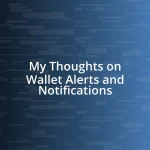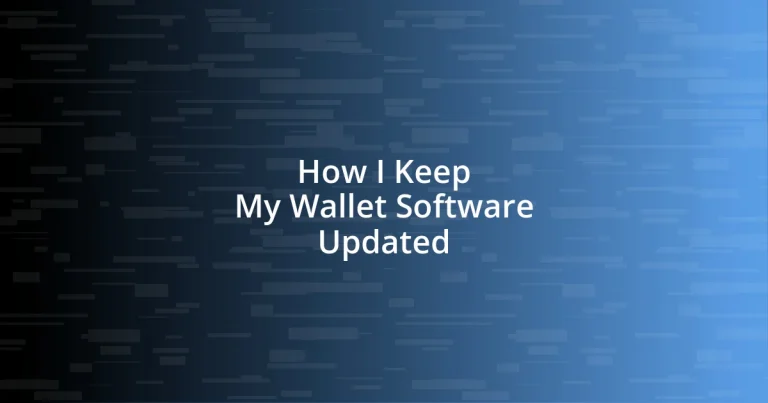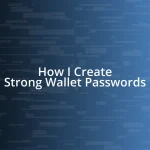Key takeaways:
- Regular updates enhance security and introduce useful features, making them essential for protecting financial information.
- Establishing a routine to check for and apply updates, including backing up data, ensures a smoother and safer wallet experience.
- Staying vigilant against phishing attempts and reading release notes are critical practices for maintaining secure updates and understanding software changes.

Understanding Wallet Software Updates
Understanding wallet software updates is essential for keeping your financial information secure. I remember the first time I procrastinated on an update, thinking it was just another annoying reminder. But then, a security breach in another app made me realize how critical it is to stay current.
When new features are rolled out or bugs are fixed, those updates often do more than just improve usability; they also enhance security measures. Can you imagine the relief of knowing you’ve taken steps to protect your assets? I’ve found that staying updated not only saves me from potential disasters but also helps me make the most of the latest features.
Sometimes, I like to think of these updates as a safety net. Just like you wouldn’t drive a car without checking the brakes, keeping my wallet software updated gives me peace of mind. It turns a daunting task into a simple act of self-care, and trust me, that kind of proactive approach can be a game changer!

Why Regular Updates Matter
Staying on top of wallet software updates is crucial to protecting sensitive financial data. I once ignored an update notification, thinking it wouldn’t impact how I managed my transactions. A few weeks later, I heard about a vulnerability that had exploited users who hadn’t updated—talk about a wake-up call! Seeing how easily things could go wrong made me realize that neglecting these updates could lead to significant financial risks.
Regular updates also ensure that you’re using the latest security protocols. I remember getting a message that a particular encryption method was outdated, and it struck me how vital these updates are. It’s like changing the locks on your door; when you upgrade, you’re adding that extra layer of protection against unwanted access. This awareness has turned the update process into an essential part of how I safeguard my finances.
Moreover, updates can introduce handy features that streamline my budgeting process. I still think back to when an update added a tool that automatically categorizes my spending. It was like having a personal assistant for my wallet! When you understand the value behind regular updates, you start to see them as enhancements rather than interruptions.
| Update Frequency | Impact on Security |
|---|---|
| Regular Updates | Higher security; fewer vulnerabilities |
| Infrequent Updates | Increased risk; exposure to threats |

How to Check for Updates
When it comes to checking for updates on my wallet software, I have developed a little routine that keeps things smooth and simple. I always start by navigating to the settings or preferences section within the app, which usually has a dedicated tab for updates. It’s like my personal checklist; whenever I open the app, I instinctively take a moment to check for any available updates, ensuring that I’m not missing out on anything crucial.
Here are some steps I follow when checking for updates:
- Open the Wallet App: Launch your wallet software on your device.
- Navigate to Settings: Look for a gear icon or menu labeled “Settings” or “Preferences.”
- Check for Updates: Find the section that says “Updates” and tap on it to see if any new versions are available.
- Automatic Notifications: Make sure to enable notifications for updates, so you’re alerted when new versions are ready for download.
- Update Notes: If an update is available, read the release notes to understand what improvements or fixes have been implemented.
I can’t emphasize enough how much peace of mind I get from this routine. The clarity of knowing my software is up to date feels like a shield against potential threats. Just last month, I discovered an update that patched a known security flaw—had I skipped my usual check, I could have been vulnerable to a breach. It’s those little moments of diligence that save me from larger headaches down the line.

Manual Update Process Explained
To ensure my wallet software is up to date, I go through a manual update process that feels almost like a little ritual. After checking for updates, if I find one available, I make a habit of reading the details about what the update includes. It’s interesting how knowing exactly what’s being fixed or improved beforehand can ease any tension I might feel about making changes. Have you ever hesitated to update because you weren’t sure what it would do?
When I initiate the update, I take a moment to back up my data. There was a time—early in my wallet software journey—when I skipped this step and lost crucial transaction history. That experience taught me the hard way that having a backup can save you from potential disaster. So now, making a backup feels like putting on a seatbelt before starting the drive—it’s a simple precaution that offers peace of mind.
After the update is complete, I always take a moment to explore the new features or changes. I remember discovering the budgeting tool after an update, and I was thrilled! It felt like a gift rather than just a process I had to go through. Isn’t it amazing how these updates can enhance our experience, all while actively protecting us? Each time I engage with this process, it reinforces the notion that manual updates aren’t just necessary; they can also be quite rewarding.

Automating Your Wallet Updates
Automating wallet updates has been a game-changer for me. I remember when I used to dread the thought of missing a critical security patch because I overlooked checking for updates. Now, I set my wallet software to automatically download updates. It’s a simple adjustment that provides me comfort, knowing I’m always secure without having to lift a finger.
I also appreciate how many wallets allow for automatic installations. The moment I see that little notification ping that says my update is ready, it feels almost like receiving a small gift. Have you ever felt that rush of excitement just knowing that your software can evolve with the times? For me, automation isn’t just about convenience; it’s a proactive defense that keeps my transactions safe and smooth.
Sometimes, though, I find myself double-checking the auto-update settings just to be sure they’re active. I remember one instance when my software didn’t properly update overnight due to a network issue. It nudged me to realize that even automation needs a little oversight. After that, I set my notifications to alert me if updates fail to install. It’s all about creating that balance of automation and awareness—ensuring my wallet is both up-to-date and secure.

Common Issues During Updates
Sometimes, during an update, I encounter unexpected issues that can be quite frustrating. For instance, I remember one update that unexpectedly required a larger amount of storage space than I anticipated. I found myself scrambling to delete files I hadn’t touched in ages! Have you ever experienced that moment of panic when your device seems to fall short right when you need it? It just goes to show the importance of checking system requirements beforehand.
Another common hurdle can be compatibility problems. A while back, I upgraded my wallet software, only to find that it didn’t play nicely with my operating system’s previous version. Ugh, the annoyance was real! I had to revert to an older version and wait for a patch that resolved the issue. It’s within these moments that patience truly becomes a virtue, isn’t it?
Finally, there’s the dreaded connectivity issue that can halt the whole update process. I once faced a situation where my internet dropped right as I initiated an important security patch. That was a heart-stopping moment; I had to make sure nothing corrupted during the partial update. These experiences remind me how vital a stable connection is—not just during updates, but in our digital lives overall.

Best Practices for Secure Updates
Ensuring secure updates is paramount in protecting my wallet software. I remember one time, I received an email claiming that an update was available. My gut instinct told me to pause and verify if it was legitimate. I quickly checked the official website instead and found that it was just a phishing attempt. It’s surprising how often these kinds of scams pop up! Always look for updates directly from the software or trusted sources—your data is worth that extra caution.
Another key practice I’ve adopted is reading the release notes before updating. Initially, I would just rush through this step, but I’ve learned that these notes can provide vital information regarding security improvements or known issues. One particularly enlightening update taught me about a new feature that significantly enhanced my transaction speed. Did you know that sometimes updates come with hidden gems? By taking a moment to skim through these notes, I can understand what changes are being made and how they impact my experience.
I also prioritize a backup strategy before applying updates, which has saved me on more than one occasion. A while ago, I decided to update my wallet software but faced unexpected glitches that disrupted my access. Thankfully, I had made a recent backup, allowing me to restore everything in a flash. It made me realize that taking a few minutes to back up data can prevent hours of anxiety. Have you ever considered how a simple action can save you from potential headaches later?














